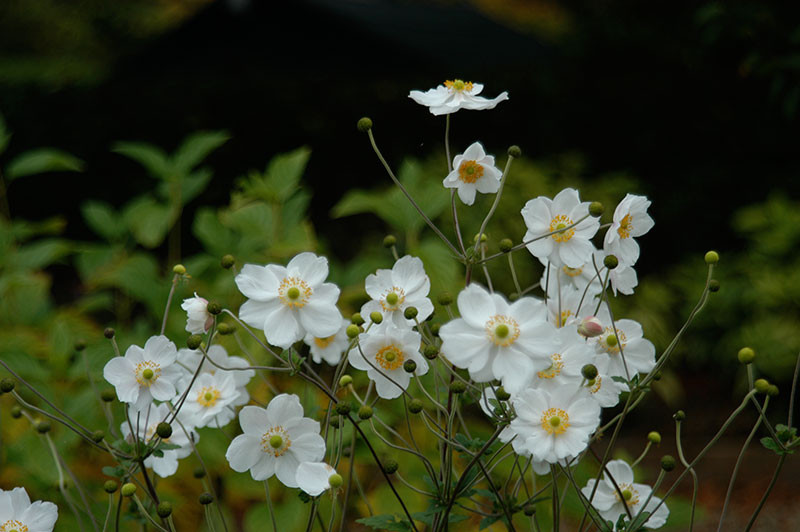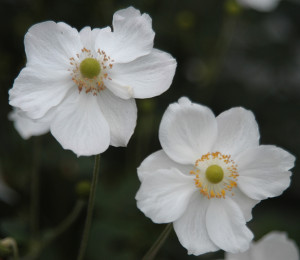
Perennial Solutions: Anemone x hybrida ‘Honorine Jobert’
Japanese anemone or windflowers gracefully brighten up the fall landscape. Anemone ‘Honorine Jobert’ has a long history, stretching back to 1858 when it was discovered by M. Jobert in Verdun, France.
With its statuesque habit, ‘Honorine Jobert’ provides an impressive display of single white flowers with a cluster of bright yellow stamens in their centers on wiry, branched stems held well above the rich deep green foliage. Blooming begins in the late summer and lasts until the early fall.
Windflowers prefer sites with full sun to partial shade and moist, but not saturated, soils. Anemone will do best when grown under light shade in Southern locations. ‘Honorine Jobert’ grows well throughout USDA Hardiness Zones 4 to 9. It develops attractive clumps typically reaching 2 feet across, but can spread to 4 feet wide. The blooms are held on 3- to 4-foot-tall flower stems and last for approximately one month.
With its longevity in the landscape, fall flowering, overall toughness and other attributes, Anemone ‘Honorine Jobert’ was selected by the Perennial Plant Association (www.perennialplant. org) as the 2016 Perennial Plant of the Year. The late season bloom and graceful flowers of ‘Honorine Jobert’ will make a great addition to your fall perennial programs.
PROPAGATION
Anemone ‘Honorine Jobert’ is vegetatively propagated. Most commercial growers propagate anemone from root cuttings in the fall or early winter. This is done by harvesting roots from the bottom third of containerized plants, cutting them into 1- to 4-inch pieces, which are 1⁄8 to 1⁄4 inch thick. These root cuttings can be stuck into liner trays or scattered across growing mix in open flat trays and covered with additional growing medium. Thicker roots tend to root better than thinner ones.
Generally, root cuttings are kept at cool temperatures for the duration of the winter. Several propagators provide minimum heat (40° F) during the winter. After they have received about six weeks of cold, the temperatures can gradually be increased to 65° F to promote root and shoot development. Once the temperatures are increased, allow six to eight weeks until they are well rooted and large enough for transplanting.
PRODUCTION
Anemone ‘Honorine Jobert’ is suitable for production in 1- to 2-gallon sized containers. Plant the liners into a porous, well- drained growing mix so the original soil line of the liner is even with the surface of the growing medium of the new container.
Windflowers prefer to be grown with light to moderate fertility levels. Growers can deliver nutrients using water-soluble fertilizers with each irrigation applying 100 to 125 ppm or using 200 to 250 ppm every other irrigation. Nutrients also can be delivered using controlled- release fertilizers by topdressing with the medium recommended rate on the fertilizer label or incorporating into the growing mix prior to planting using a rate equivalent to 1.0 to 1.25 pounds of elemental nitrogen per yard of growing mix. During production, maintain media pH levels with the range of 5.8 to 6.2.
 Anemone requires average to slightly above average amounts of irrigation. Never allow the plants to dry out and wilt as leaf scorch and irreversible damage to the buds and flowers may occur. Keep them moderately moist, but not saturated throughout production. Water thoroughly when irrigation is applied and allow the growing mix to dry out slightly between waterings.
Anemone requires average to slightly above average amounts of irrigation. Never allow the plants to dry out and wilt as leaf scorch and irreversible damage to the buds and flowers may occur. Keep them moderately moist, but not saturated throughout production. Water thoroughly when irrigation is applied and allow the growing mix to dry out slightly between waterings.
For the best quality, grow the plants outside in full sun. Providing some shade during the heat of the day is beneficial, but avoid keeping them under continuous shade. Extreme heat can delay flowering. No pinching or maintenance is necessary to produce full, high-quality plants.
Throughout most of the production cycle, the plants will not require height management strategies. Some growers find it beneficial to reduce the size of the flower stems to maximize shipping efficiencies. Before using height-management tools, consider shipping the plants as the flower stems are first beginning to develop rather than waiting for the flowers to open. Spray applications with the tank mixture of 2,000-ppm daminozide (B-Nine or Dazide) plus 3-ppm uniconazole (Sumagic or Concise) can be applied just as the flower stems are elongating. Ideally the first application should be applied before the flower stems rise above the canopy. An additional application can be applied seven days following the first if additional height control is anticipated.
INSECTS AND DISEASES
There are several insect pests and diseases known to attack Anemone; however, most of them do not cause significant damage. Growers may find aphids, black blister beetles, foliar nematodes, fungus gnat larvae, root knot nematodes and western flower thrips feeding on occasion. The most common diseases which infect Anemone include Botrytis, downy mildew, fungal leaf spots, Phytopthora, powdery mildew, Pythium, Rhizoctonia, rust and Sclerotium.
Windflowers are also susceptible to several viruses including Anemone mosaic virus (AMV – vectored by aphids), cucumber mosaic virus (CMV – vectored by aphids) and Impatiens necrotic spot virus (INSV – vectored by thrips).
Growers should utilize routine scouting programs to detect the presence of insects and diseases early and to determine if and when control measures are necessary. Keep in mind that aphids and thrips can vector viruses and the presence of these insects should be monitored more routinely.
TEMPERATURE AND SCHEDULING
Anemone ‘Honorine Jobert’ is most commonly grown for fall sales. This cultivar can be produced in bloom for earlier sales; however, most growers typically only offer it in bloom in the fall.
There is a juvenile phase the plants usually undergo, particularly when propagated by root divisions. Juvenile plants will have leaves with single lobes, while mature plants that are capable of flowering will have trilobed leaves present. Once the plants develop trilobed leaves they can be induced to flower.
Vernalization is not required for flowering, but they are considered to be cold beneficial plants. Anemone that have been vernalized will be more vigorous and will generally flower more uniformly. They have an obligate long day requirement and, compared with many perennials, have a long time to bloom after the onset of long day lengths.
Planting large, vernalized liners (21-cell or larger) which have been bulked up prior to overwintering can be planted in the late spring to produce flowering plants by the late summer. The highest quality plants with the most consistent flowering are obtained when they are planted in the fall, overwintered and sold in the late summer of the following year.
If spring or early summer flowering is desired, it is best to force containers which have been overwintered. It will be necessary to provide photoperiodic lighting using day extension or night interruption lighting to obtain flowering when the natural day lengths are less than 14 hours. After the onset of long days, it takes approximately 13 weeks for them to bloom when they are grown with 24-hour average temperatures of 68° F.
AVAILABILITY
Anemone x hybrida ‘Honorine Jobert’ is widely produced and available from several reputable perennial propagators and growers.


 Video Library
Video Library 




















